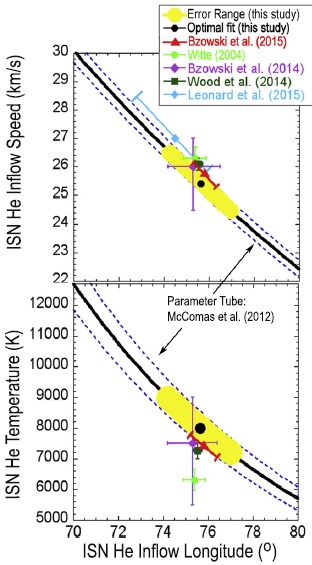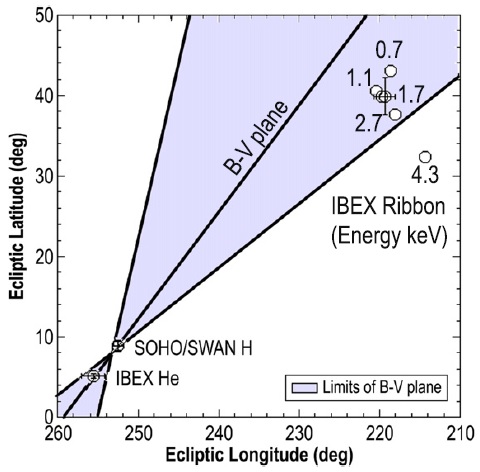
Abstract: Interstellar He represents a key sample of interstellar matter that, due to its high first ionization potential, survives the journey from beyond our solar system’s heliospheric boundaries to Earth. Ongoing analysis of interstellar neutral (ISN) He atoms by the Interstellar Boundary Explorer (IBEX) has resulted in a growing sophistication in our understanding of local interstellar flow. A key feature of the IBEX observations near perihelion of the ISN trajectories is a narrow “tube” of approximately degenerate interstellar parameters. These degenerate solutions provide a tightly coupled relationship between interstellar flow longitude and latitude, speed, and temperature. However, IBEX analysis resulting in a specific solution for inflow longitude, inflow speed, temperature and inflow latitude was accompanied with a sizeable uncertainty along the parameter tube. Here, we use the three-step method to find the interstellar parameters: 1) the ISN He peak rate in ecliptic longitude determines uniquely a relation (as part of the tube in parameter space) between the longitude λISN∞ and the speed VISN∞ of the He ISN flow at infinity; 2) the ISN He peak latitude (on the great circle swept out in each spin) is compared to simulations to derive unique values for λISN∞ and VISN∞ along the parameter tube; 3) the angular width of the He flow distributions as a function of latitude is used to derive the interstellar He temperature. For simulated peak latitudes, we use a relatively new analytical tool that traces He atoms from beyond the termination shock into the position of IBEX and incorporates the detailed response function of IBEX-Lo. By varying interstellar parameters along the IBEX parameter tube, we find the specific parameters that minimize the chi-square difference between observations and simulations. The new computational tool for simulating neutral atoms through the integrated IBEX-Lo response function makes no assumptions or expansions with respect to spin axis pointing or frame of reference. Thus, we are capable of moving beyond closed form approximations and utilize observations of interstellar He during the complete 5 year period from 2009 to 2013 when the primary component of interstellar He is most prominent. Chi-square minimization of simulations compared to observations results in a He ISN flow longitude 75.6 degrees ± 1.40 degrees, latitude −5.12 degrees ± 0.27 degrees , speed 25.4 ± 1.1 km/s, and temperature 8000 ± 1300 K, where the uncertainties are related and apply along the IBEX parameter tube. This paper also provides documentation for a new release of ISN data and associated model runs.
IBEX data used in the Schwadron et al. 2015 analysis to compute interstellar He parameters. Data are included for each position along the parameter tube as defined by the inflow speed. The inflow speed is given by the filename (i.e. runex-22.888889.txt – 22.9 km/s inflow speed).

